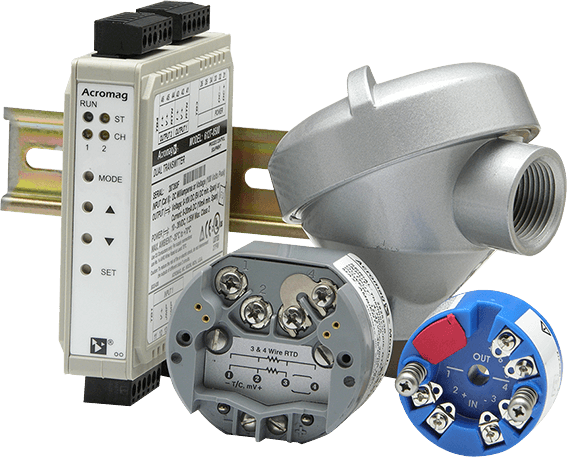What is Signal Conditioning?
What is Signal Conditioning?

Signal conditioning, with respect to process monitoring and control engineering applications, is the practice of preparing a raw input signal for use with instrumentation in a data acquisition and/or control system. The process typically involves one or more of the following steps: isolating, filtering, amplifying, and converting a sensor input signal to a proportional output signal that is transmitted to another control device or system. Sometimes a signal conditioner can perform computation functions such as totalization, integration, pulse-width modulation, linearization, and other math operations on a signal.
Common industrial signal conditioners accept voltage, current, frequency, resistance, or strain gauge input types. Acromag’s various signal conditioning instruments are categorized as process transmitters, signal isolators, math/computation modules, panel meters, and remote I/O modules.
Why is Signal Conditioning Required?
Signal conditioning is essential for optimizing signals before data processing. Accurate signal measurement depends on this optimization. Additionally, signals collected from sensors are often not in the proper format and may contain unwanted noise, which can compromise the quality of the signal data.
Types of Signal Conditioning
Signal conditioning can be categorized into several types based on the specific tasks involved in manipulating the signal. Here are some common types:
-
- Amplification: This type of signal conditioning involves increasing the magnitude of the signal. Amplification is often necessary to boost weak signals, match signal levels between different components of a system, or improve signal-to-noise ratio.
- Filtering: Filtering is used to remove unwanted noise or frequency components from the signal. Different types of filters, such as low-pass, high-pass, band-pass, or band-stop filters, can be employed depending on the specific requirements of the application.
- Modulation and Demodulation: Modulation is the process of encoding information onto a carrier signal, while demodulation is the process of extracting the original information from a modulated signal. Modulation and demodulation are essential in communication systems and are also used in various other applications.
- Isolation: Isolation involves electrically separating different parts of a system to prevent interference or damage. Isolation techniques, such as using optocouplers or transformers, are commonly employed in applications where galvanic isolation is required.
- Conversion: Signal conversion involves converting the signal from one form to another. This can include analog-to-digital conversion (ADC) and digital-to-analog conversion (DAC). ADCs are used to convert analog signals into digital format for processing or storage, while DACs are used to convert digital signals back into analog format for output.
- Linearization: Linearization is used to adjust the signal to ensure a linear relationship between the input and output. This is often necessary in sensors and transducers where the relationship between the physical quantity being measured and the electrical signal produced may not be linear.
- Conditioning for Sensor Interfacing: This type of signal conditioning involves preparing signals from sensors for further processing or analysis. It may include amplification, filtering, linearization, and other techniques tailored to the specific characteristics of the sensor and the application.
- Amplification: This type of signal conditioning involves increasing the magnitude of the signal. Amplification is often necessary to boost weak signals, match signal levels between different components of a system, or improve signal-to-noise ratio.
These types of signal conditioning are often combined and tailored to the specific requirements of a particular application, with the goal of improving the accuracy, reliability, and performance of the overall system.
For more information, please refer to the resources below.
Wikipedia: Signal Conditioning
Application Note: Signal Conditioning – Getting the most for your money
Whitepaper: Introduction to the Two-Wire Transmitter and the 4-20mA Current Loop
Technical Reference: Introduction to Strain & Strain Measurement